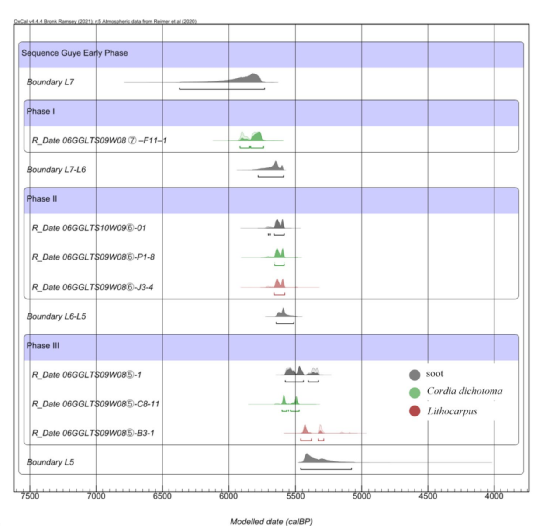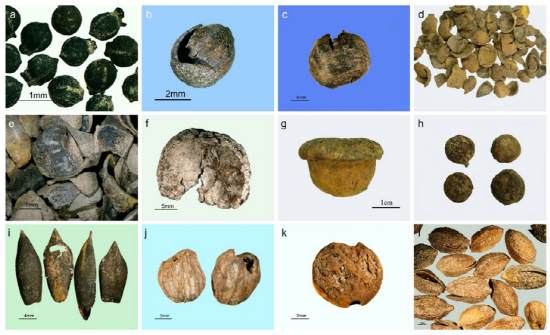Archaeol. Anthrop. Sci.|Selective Intensified Use of Acorns in Subtropical South China
Recently, the Center for Archaeological Sciences, Sichuan University, in collaboration with Jinan University, the Guangdong Provincial Institute of Cultural Relics and Archaeology, and other institutions, published the latest findings on the intensified use of Lithocarpus plants excavated from the Guye site in Foshan City, Guangdong Province, in the internationally renowned anthropological and archaeological journal *Archaeological and Anthropological Sciences*. The study reveals differences in the types of acorns utilized by prehistoric peoples in different regions. Assistant Researcher Ma Yongchao from the Center for Archaeological Sciences is the sole corresponding author of the paper. Lecturer Li Zhao from Jinan University is the first author. Research Curator Li Yan from the Guangdong Provincial Institute of Cultural Relics and Archaeology, Professor Yang Xiaoyan from Lanzhou University, and others are co-authors.

Nuts from the Fagaceae family are an important plant-based food resource relied upon by hunter-gatherer groups worldwide. These nuts encompass numerous genera, but in previous research, they have often been collectively referred to as "acorns" without further in-depth analysis. On the other hand, detailed botanical taxonomic studies in certain regions show clear differences in the acorns selected by hunter-gatherers from different areas. For example, Castanopsis was favored by populations in Southeast Asia, while prehistoric people in temperate Northeast Asia preferred Quercus or Chinese chestnut (Castanea mollissima). So, what were the nut choices of hunter-gatherer groups in Holocene subtropical South China, an area covered by Fagaceae forests?

Location map of the Guye site
To answer this question, the Center for Archaeological Sciences and other institutions conducted systematic archaeobotanical research at the Guye site. The site is divided into four excavation areas, and the macro-botanical remains analyzed in this study primarily come from the modern paddy field area. Due to the high water table, layers 5, 6, and 7 in the paddy field area preserved a large quantity of plant seeds, fruits, and their fragments. After processing the AMS 14C dating data of these plant remains using a Bayesian model, their ages were concentrated between 6000-5300 cal. BP.

Dating of plant remains from the Guye site
Systematic botanical taxonomy and quantification show that, in addition to numerous complete fruits and seeds such as sawgrass (Cladium jamaicense subsp. chinense) and Chinese white olive (Canarium album), countless Fagaceae fragments, predominantly Lithocarpus, were also discovered. This finding provides new insights into the diversity and formation of the diet of ancient humans in Holocene subtropical South China, mainly reflected in three aspects.

Examples of plant seeds and fruits unearthed from the Guye site (c-f are Lithocarpus fragments, g-h are complete Lithocarpus specimens)
First, previous studies suggested that the plant-based diet of prehistoric hunter-gatherers in South China relied heavily on roots and tubers like taro, and palms. The analysis from the Guye site indicates that Lithocarpus fruits were also one of their main sources of starchy food. The fact that Lithocarpus remains were mostly found as fragments (likely due to breaking the shells during consumption) rather than whole individuals further supports this.
Second, the choice of acorns by the ancient inhabitants of the Guye site reflects strong regional characteristics. As mentioned above, this differs from the preferences of prehistoric peoples in Southeast Asia and Northeast Asia, and stands in stark contrast to the fondness for Quercus and Cyclobalanopsis among contemporaneous and slightly earlier populations in the Yangtze River Basin. On the other hand, paleovegetation reconstructions based primarily on pollen data show that both Lithocarpus and Quercus were dominant species in the natural vegetation. Compared to the latter, several characteristics of Lithocarpus may have made it the optimal choice for the Guye inhabitants, such as their tendency to fall concentratedly during the ripening season, making them easy to collect, their higher starch content, and lower tannin levels.

Statistical chart of Lithocarpus unearthed from the Guye site
a. Percentage of immature individuals among complete specimens; b. Statistics on the ripening seasons of Lithocarpus plants
*Referencing modern botanical studies, a total of 51 species of Lithocarpus were included in this statistic.
Third, the ancient inhabitants of the Guye site had a good understanding of the ecological characteristics of Lithocarpus and may have established an adaptive diet. Firstly, statistics on immature individuals among complete Lithocarpus specimens show that their proportion gradually decreased over time. Secondly, analysis of the ripening seasons of various Lithocarpus species in South China indicates that they can essentially cover the entire year. In other words, the Guye people could obtain a continuous supply of starchy food throughout the year. This stable forest-based plant diet may have slowed their adoption of cereal agriculture.
In summary, this study not only reveals the regional diversity in acorn selection and forest environment adaptation among subtropical hunter-gatherer populations in China but also provides a valuable case study for discussing the varying rates of cereal agriculture diffusion to non-origin centers.
